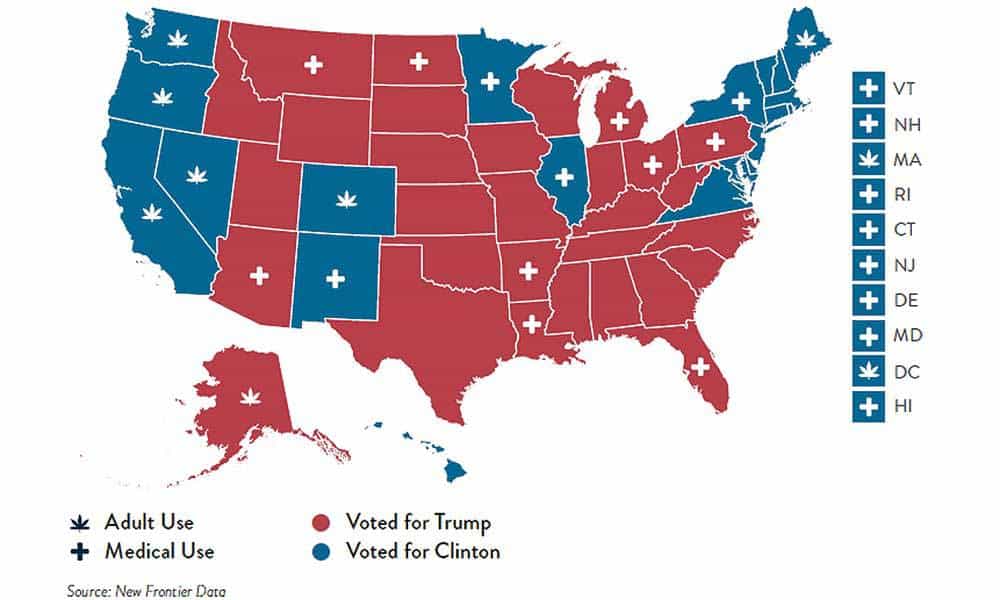The post Will California Be The Domino Needed To End Federal Prohibition? appeared first on High Times.
November is traditionally election season in the United States, but even apart from being an off-year cycle at the polls, this fall looks to be very quiet compared with last year’s watershed events for the cannabis industry and the legalization and reform movement nationwide.
How 2016 Elections Shaped Marijuana Reform
A year ago, voters in five states—Arizona, California, Maine, Massachusetts and Nevada—went to the polls to decide whether to legalize the adult use of cannabis, while voters in four other states—Arkansas, Florida, Montana and North Dakota—passed medical cannabis programs. Only the residents of Arizona voted against legalization.
Last year’s biggest story by far was California, and not only because the vote there ultimately made cannabis legal along the entire West Coast. In November 2016, 57 percent of Californians voted for Proposition 64, the Adult Use of Marijuana Act (AUMA), to establish a regulated recreational-pot program in the nation’s most populous state. Prop. 64 allows adults 21 and older to possess up to one ounce of cannabis and to grow up to six plants at home.
2016 Election Results Underscore Bipartisan Support For Legalization

Beyond laying the groundwork for a statewide regulatory system, AUMA also creates two taxes on cannabis businesses, one on cultivation and the other on retail sales. The state will begin accepting applications for cannabusiness licenses in January 2018, though recreational sales and many of the law’s taxing and licensing provisions won’t take effect until midyear.
California’s state motto is “Eureka” (“I found it”), and what we find there in the coming years will inform America’s cannabis industry and its social influences in profound ways. As the world’s sixth-largest economy, California’s embrace of a legal adult-use program will automatically make it the capital of the nation’s cannabis market. With a population of nearly 40 million people, and having already established a medical cannabis market worth about $2.7 billion, California is poised to become the world’s epicenter of both cultivation and social use.
As noted in New Frontier Data’s Cannabis Industry Annual Report: 2017 Legal Marijuana Outlook, the legal cannabis market in the United States was worth an estimated $6.6 billion in 2016, with annual sales projected to grow at a compound annual rate of 16 percent and reach more than $24 billion by 2025.
In California alone, legal cannabis sales are projected to reach $2.8 billion in 2017; supported by the activation of a regulated adult-use market, annual sales are projected to grow at a compound annual rate of 12 percent over the following eight years, reaching an estimated $6.6 billion just in that state come 2025.
Luke Stanton is the managing partner of the Frontera Law Group, based near Los Angeles. When it opened in 2015, Frontera became one of the first law practices in California to focus specifically on cannabusiness issues.
Final Hit: Will California Be The Domino Needed To End Federal Prohibition?
Looking forward to the long-awaited opening of the state’s adult-use market in 2018, Stanton has solid expectations for both the short and long term. He believes that the first major effect of Prop. 64 will be cannabis companies’ acquiring greater access to capital markets and the investment community.
Further out, he anticipates California’s adoption of an adult-use market to represent the “big domino we needed to see fall nationally, and the harbinger of the end of cannabis prohibition in America. It’s not going to be immediate,” Stanton adds, “but it’s coming.”
Stanton envisions a timeframe in which the California market fully comes into its own somewhere between 2020 and 2022.
“I think that’s just the amount of time it’s going to take guys who are growing large-scale to get their systems dialed in,” he says. “And then in five years, of course, under AUMA, all the canopy-size limits come off. Then you’re going to see people come in—I’m sure from Big Tobacco and other worlds—and try to mass-produce quality cannabis, which I think will be hard to do. But I think that’s when you’ll see commoditization hit California.”
The post Will California Be The Domino Needed To End Federal Prohibition? appeared first on High Times.



0 DL LiNKS:
Post a Comment
Add yours...